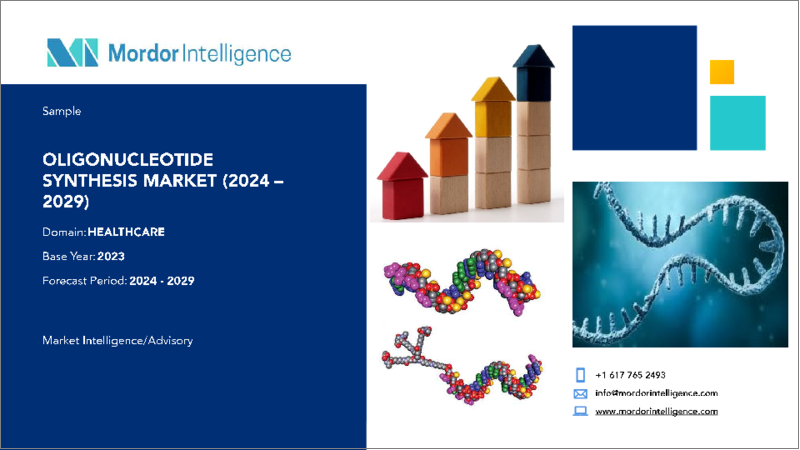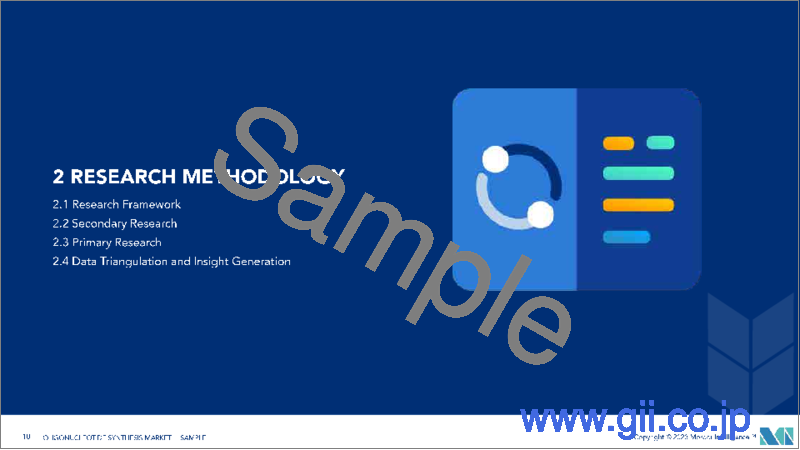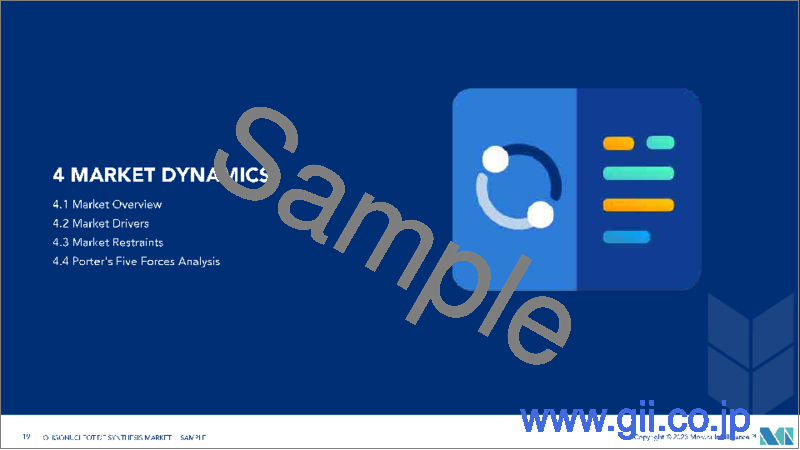|
|
市場調査レポート
商品コード
1197798
オリゴヌクレオチド合成市場- 成長、動向、予測(2023年-2028年)Oligonucleotide Synthesis Market - Growth, Trends, and Forecasts (2023 - 2028) |
||||||
|
● お客様のご希望に応じて、既存データの加工や未掲載情報(例:国別セグメント)の追加などの対応が可能です。 詳細はお問い合わせください。 |
|||||||
| オリゴヌクレオチド合成市場- 成長、動向、予測(2023年-2028年) |
|
出版日: 2023年01月23日
発行: Mordor Intelligence
ページ情報: 英文 115 Pages
納期: 2~3営業日
|
- 全表示
- 概要
- 目次
オリゴヌクレオチド合成市場は、予測期間中に12.3%のCAGRで推移すると予想されています。
COVID-19は、オリゴヌクレオチド合成市場の成長に影響を与えています。COVID-19診断薬の需要増は、今度は分子診断製品の基礎となるオリゴヌクレオチド原料の世界の需要を増加させています。2022年3月にPLOS Oneに掲載された研究では、オリゴヌクレオチドがコロナウイルスゲノム内の5'-polyUを標的とすることに成功したことが確認されました。また、5'-polyUのような必須変異標的を用いたCOVID-19治療薬の開発は、新しいSARS-CoV-2の生産と拡散を抑えることができます。このような調査研究は、医薬品開発におけるオリゴヌクレオチドの需要や採用に影響を与え、パンデミック時の市場成長に影響を与えています。
さらに、さまざまな企業がオリゴヌクレオチド合成に投資しており、予測期間中の市場成長を高めると予想されます。例えば、2021年9月、SpeeDx社は、サプライチェーンのリスクを低減し、重要な診断薬のより重要なソブリン能力を開発するために、現地のオリゴヌクレオチド製造に投資しています。このような開発は、予測期間中の市場成長を促進すると予想される医薬品開発におけるオリゴヌクレオチドの採用を増加させることが期待されます。
その他の重要な要因としては、製薬会社やバイオテクノロジー企業に対する政府投資や研究開発費の増加、分子診断や臨床応用における合成オリゴヌクレオチドの利用が挙げられます。
複数の慢性疾患や希少疾患を治療するための高度な治療薬を開発するため、さまざまなゲノムプロジェクトに資金を調達する政府の取り組みが活発化しています。これにより、医薬品開発用のオリゴヌクレオチドに対する需要が高まり、市場の成長が促進されると予想されます。例えば、2022年9月、米国国立衛生研究所は、脳のヒトゲノムプロジェクトの次の段階を開始するために6億米ドル以上を投資しました。この資金は、特定の脳細胞集団に治療薬や他の分子を標的にする新しい方法を考案するのに役立ちます。
さらに、オリゴヌクレオチドベースの医薬品の開発を後押しする企業や政府のイニシアティブの高まりや、医薬品・バイオテクノロジー業界におけるオリゴヌクレオチド技術の採用も、市場の成長を高めると予想されます。例えば、2021年2月、CPIはMedicines Manufacturing Innovation Centreにおいて、オリゴヌクレオチドの製造に革命をもたらすプロジェクトを立ち上げました。Medicines Manufacturing Innovation Centreは、AstraZeneca、Exactmer、Novartis、UK Research and Innovationとの共同研究を開始し、オリゴヌクレオチド(合成DNAまたはRNAの短い鎖)の拡張可能、持続可能、かつよりコスト効率の高い医薬品製造プロセスを開発します。この開発により、このエキサイティングな新種の医薬品の生産能力と生存率が向上し、予測期間中の市場成長率が高まると期待されています。
さらに、分子診断や臨床応用におけるオリゴヌクレオチドの採用が増加していることも、市場成長に寄与しています。例えば、2022年2月、イリノイ大学アーバナの研究者は、がん検出のための新しいmiRNAポイントオブケア検査を開発しました。この検査は、ナノ粒子を使用して、ヒト血清中の腫瘍特異的なマイクロRNA(miRNA)を捕捉するものです。2021年1月、ダイアジェノードは、MGIのDNBSEQシーケンサーに対応した新しいsmall RNA-sequencing solution、D-Plex Small RNA DNBSEQ Kitを発売しました。本キットは、独自のD-Plex技術を用いたライブラリー調製により、超微量なRNA入力で高いパフォーマンスを発揮し、多様なsmall RNA転写産物を検出することができます。
このため、研究開発や施設の整備が進み、調査対象市場は予測期間中に拡大することが予想されます。しかし、オリゴヌクレオチドの高い処理コスト、未開発国における熟練した専門家と研究サポートの不足が、予測期間中のオリゴヌクレオチド合成市場の成長を妨げると予想されます。
オリゴヌクレオチド合成市場の動向
治療薬セグメントは高いCAGRで推移すると予想される
治療分野は、慢性疾患や希少疾患の有病率の増加、医薬品開発におけるオリゴヌクレオチドの採用拡大、製品上市の増加などの要因により、予測期間中にオリゴヌクレオチド合成市場で大きな成長を示すと予想されます。
オリゴヌクレオチド治療薬は、アンチセンス・オリゴヌクレオチドや低分子干渉RNA(siRNA)を用いてRNAやタンパク質を標的とする治療薬として分類されます。オリゴヌクレオチド治療薬には、転写因子に集中して転写を阻止するデコイ、特定のmRNAに相補的なマイクロRNA(miRNA)の発現を調節するもの、mRNAから特定のタンパク質の翻訳を制限するものなどがあります。例えば、2022年2月にFuture Medicineに掲載された記事によると、オリゴヌクレオチド治療薬は、希少疾患の治療薬を作るための最も適応性の高いプラットフォームの1つであるとされています。
また、成長企業が提携や融資など、さまざまな事業戦略の採用に力を入れていることも、市場の成長に寄与しています。例えば、2022年1月、Ceptur Therapeutics, Inc.は、配列特異的mRNAとU1小核リボ核タンパク質に関与する二価オリゴヌクレオチドである独自のU1アダプター技術に基づくRNA治療薬の開発を進めるため、venBio PartnersとQiming Venture Partners USAが主導したシリーズA融資ラウンドで7500万米ドルを獲得することに成功しました。U1 small nuclear ribonuclear proteinは、転写とスプライシングを制御する細胞内の機械です。U1 snRNPと相互作用する合成オリゴヌクレオチドを利用することで、この転写制御因子を利用してmRNAを高度に標的化して制御することが可能になります。
さらに、製品の上市や承認の増加により、オリゴヌクレオチド医薬品の需要が高まり、市場の成長が促進されると予想されます。例えば、2021年2月、USFDAは、DMD遺伝子の変異が確認された患者におけるデュシェンヌ型筋ジストロフィー(DMD)の治療薬としてアモンディス45(カジメルセン)注射剤を承認しました。
さらに、さまざまな企業がオリゴヌクレオチド治療薬を開発しており、製薬・バイオテクノロジー業界での採用が進み、市場の成長を後押しすると予想されます。例えば、clinicaltrials.govによると、2022年7月現在、TME TherapeuticsはSTNM01を開発しており、切除不能な膵臓がんを治療するために第I相臨床試験で評価中です。また、日東バイオファーマはND-L02-s0201を開発中で、特発性肺線維症(IPF)を対象にフェーズII試験で評価を進めています。
このように、オリゴヌクレオチドを用いた医薬品開発のための様々なビジネス戦略を採用する企業活動の増加や新製品の上市などの要因から、この分野は予測期間中に成長すると予想されます。
北米が調査対象市場で重要なシェアを占める見込み
北米は予測期間中、市場を独占すると予想されます。市場成長の要因は、人口の間で慢性疾患や希少疾患の有病率が上昇していること、企業による研究開発費の増加、同地域における主要な市場プレイヤーの存在です。
Cancer Facts and Figures 2022によると、2022年に米国で新たに診断されるがん患者は190万人を超えると予想されています。また、Breastcancer.orgが発表した2022年の統計によると、米国では2022年に浸潤性乳がんの新規症例が287,850件、非浸潤性(in situ)乳がんの新規症例が51,400件と推定されています。人口の間でがんの負担が増加していることから、先進的な治療薬の必要性が高まり、オリゴヌクレオチド治療薬の需要を押し上げ、市場の成長を促進しています。
IDFが発表した2022年の統計によると、2021年にはカナダで約290万人が糖尿病と共存していました。この数は、2030年には320万人、2045年には340万人に達すると予測されています。このように、同国では糖尿病人口の増加が予想されることから、抗糖尿病薬の開発において、RNAおよびタンパク質レベルで疾患の原因となる遺伝子の発現を抑えることができるアンチセンスオリゴヌクレオチドの需要が高まります。このことは、予測期間中の市場成長を押し上げると予想されます。
薬剤開発の活発化や地域ごとの製品上市の高まりは、市場成長を促進すると予想されます。例えば、2022年1月、USFDAは、低密度リポタンパク質コレステロール(LDL-C)の追加低下を必要とするヘテロ接合型家族性高コレステロール血症(HeFH)または臨床動脈硬化性心疾患(ASCVD)の成人に、食事療法およびスタチン療法と共に使用するための革新的低インクリシランRNA医薬品、インクルージョン注射(Leqvio)の承認を取得しました。
さらに、clinicaltrials.govによると、2022年7月現在、TME Pharma Agisはマイクロサテライト安定転移性膵臓がん患者を対象に、Olaptesed Pegol(NOX-A12)とpembrolizumabおよびnanoliposomal irinotecan/5-FU/leucovorin or gemcitabine/nab-paclitaxelの併用によるフェーズII臨床試験を行っています。
さらに、企業によるオリゴヌクレオチド医薬品の生産増強や設備拡張のための投資が増加していることも、市場の成長に寄与しています。例えば、日東電工株式会社は2021年3月、治療用オリゴヌクレオチド事業の製造能力を高めるため、米国の子会社である日東電工アビシア株式会社などに約250億円(2億2700万米ドル)を投資する計画を明らかにしました。
北米では、がんの増加、製品の上市と承認の増加、臨床試験の実施における企業の活動の増加、オリゴヌクレオチド事業への投資の増加などの要因により、予測期間中に市場の成長が促進されると予測されています。
オリゴヌクレオチド合成市場の競合他社分析
新興国市場での買収、販売提携、新規技術開発のための協業など、さまざまな戦略を採用する多数の企業が存在し、市場は断片化しています。オリゴヌクレオチド合成業界で事業を展開している企業は、製品ポートフォリオの拡大や開発も行っており、これが市場全体の推進力となり、かなり競争力のある市場となっています。現在、市場を独占している企業には、Agilent Technologies、Thermo Fisher Scientific、Merck KGaA、Danaher Corporation、Bio-Synthesis Inc、Eurofins Scientific、Kaneka Corporation(Eurogentec), GenScript、LGC Limited(LGC Biosearch Technologies)などが含まれます。
その他の特典
- エクセル形式の市場予測(ME)シート
- アナリストによる3ヶ月間のサポート
目次
第1章 イントロダクション
- 調査の前提条件条件と市場の定義
- 調査範囲
第2章 調査手法
第3章 エグゼクティブサマリー
第4章 市場力学
- 市場概要
- 市場促進要因
- 製薬会社やバイオテクノロジー企業における政府投資と研究開発費の増加
- 分子診断と臨床応用における合成オリゴヌクレオチドの利用
- 市場抑制要因
- オリゴヌクレオチドの高い治療費
- 未開発国における熟練専門家および研究支援の欠如
- 業界の魅力- ファイブフォース分析分析
- 新規参入業者の脅威
- 買い手の交渉力
- 供給企業の交渉力
- 代替品の脅威
- 競争企業間の敵対関係
第5章 市場セグメンテーション(金額ベース市場規模:100万米ドル)
- 製品タイプ別
- オリゴヌクレオチド合成品
- 試薬
- 装置
- サービス
- 用途別
- 調査・研究
- 診断薬
- 治療薬
- エンドユーザー別
- 学術研究機関
- 製薬会社・バイオテクノロジー企業
- 病院・診断機関
- 地域別内訳
- 北米
- 米国
- カナダ
- メキシコ
- 欧州
- ドイツ
- 英国
- フランス
- イタリア
- スペイン
- その他の欧州地域
- アジア太平洋地域
- 中国
- 日本
- インド
- オーストラリア
- 韓国
- その他アジア太平洋地域
- 中東地域
- GCC
- 南アフリカ
- その他の中東地域
- 南米地域
- ブラジル
- アルゼンチン
- その他の南米地域
- 北米
第6章 競合情勢
- 企業プロファイル
- Agilent Technologies
- Thermo Fisher Scientific
- Merck KGaA
- Danaher Corporation
- Bio-Synthesis Inc.
- Eurofins Scientific
- Kaneka Corporation(Eurogentec)
- GenScript
- LGC Limited(LGC Biosearch Technologies)
- Maravai Life Sciences
- Biogen
- Sarepta Therapeutics, Inc.
第7章 市場機会と今後の動向
The oligonucleotide synthesis market is expected to register a CAGR of 12.3% over the forecast period.
COVID-19 has impacted the growth of the oligonucleotide synthesis market. The increased demand for COVID-19 diagnostics has, in turn, increased the global demand for oligonucleotide raw materials that form the basis of molecular diagnostic products. In a study published in PLOS One in March 2022, it was observed that the oligonucleotides successfully targetted 5'-polyUs in the coronavirus genome. Also, developing therapeutic COVID-19 medicines employing essential mutational targets, such as the 5'-polyU tract, can lessen the production and spread of new SARS-CoV-2. Such research studies have impacted the demand and adoption for oligonucleotides in drug development, affecting the market growth during a pandemic.
Moreover, various companies are investing in oligonucleotide synthesis, which is expected to increase market growth over the forecast period. For instance, in September 2021, SpeeDx invested in local oligonucleotide manufacturing to reduce supply chain risk and develop a more vital sovereign capacity for critical diagnostics. Such developments are expected to increase the adoption of oligonucleotides in drug development which is anticipated to fuel the market growth over the forecast period.
Other significant factors include the increasing government investments and R&D expenditure in pharmaceutical and biotechnology companies and the use of synthesized oligonucleotides in molecular diagnostics and clinical applications.
There are growing government initiatives for raising funds to develop various genome projects to develop advanced therapeutics to treat multiple chronic and rare diseases. This is expected to increase the demand for oligonucleotides for drug development, boosting the market growth. For instance, in September 2022, the National Institutes of Health invested more than USD 600 million to launch the next stage of its human genome project for the brain. This funding helps to devise new ways to target therapeutics and other molecules to specific brain cell populations.
Additionally, the rising company and government initiatives to boost the development of oligonucleotide-based drug products and the adoption of oligonucleotide technology in the pharmaceutical and biotechnology industry are also expected to increase market growth. For instance, in February 2021, CPI launched a project in the Medicines Manufacturing Innovation Centre to revolutionize the manufacture of oligonucleotides. The Medicines Manufacturing Innovation Centre launched a collaboration with AstraZeneca, Exactmer, Novartis, and UK Research and Innovation to develop a scalable, sustainable, and more cost-effective medicines manufacturing process for oligonucleotides: short strands of synthetic DNA or RNA. This development enhances the production capacity and viability of this exciting new class of medicines and is expected to increase market growth over the forecast period.
Furthermore, the increasing adoption of oligonucleotides in molecular diagnostics and clinical applications contributes to market growth. For instance, in February 2022, researchers at the University of Illinois Urbana developed a new miRNA point-of-care test for cancer detection. The test uses nanoparticles to capture tumor-specific microRNAs (miRNAs) in human serum. In January 2021, Diagenode launched a new small RNA-sequencing solution, D-Plex Small RNA DNBSEQ Kit, compatible with MGI's DNBSEQ sequencers. The kit incorporates unique D-Plex technology for library preparation enabling high performance with ultralow RNA inputs and providing diverse small RNA transcript detection.
Therefore, the studied market is expected to grow over the forecast period owing to the increasing research and development initiatives and the establishment of the facilities. However, the high treatment cost of oligonucleotides and the lack of skilled professionals and research support in undeveloped countries are expected to hinder the growth of the oligonucleotide synthesis market over the forecast period.
Oligonucleotide Synthesis Market Trends
Therapeutic Segment Expected to Register a High CAGR
The therapeutics segment is expected to witness significant growth in the oligonucleotide synthesis market over the forecast period owing to factors such as the increasing prevalence of chronic and rare diseases, along with the growing adoption of oligonucleotides in drug development and rising product launches.
Oligonucleotide therapeutics are classified as therapeutics that use antisense oligonucleotides or small interfering RNAs (siRNAs) to target RNA or protein. Oligonucleotide therapies include decoys that prevent transcription by concentrating on transcription factors, regulate the expression of complementary microRNA (miRNA) to specific mRNAs, and limit the translation of certain proteins from mRNA. For instance, as per an article published in Future Medicine in February 2022, oligonucleotide therapeutics is one of the most adaptable platforms for creating medications for rare diseases.
The growing company's focus on adopting various business strategies, such as collaborations, financing, and others, is also contributing to the market growth. For instance, in January 2022, Ceptur Therapeutics, Inc. successfully acquired USD 75 million in a Series-A financing round led by venBio Partners and Qiming Venture Partners USA to advance RNA therapeutics based on proprietary U1 adaptor technology, a bivalent oligonucleotide that engages sequence-specific mRNA and U1 small nuclear ribonuclear protein. The U1 small nuclear ribonuclear protein is a ubiquitous intracellular machine that regulates transcription and splicing. Utilizing synthetic oligonucleotides that interact with U1 snRNP offers the ability to co-opt the key transcriptome regulator to regulate mRNA in a highly targeted manner.
Furthermore, increasing product launches and approvals are expected to increase the demand for oligonucleotide drugs, propelling the market growth. For instance, in February 2021, the USFDA approved an Amondys 45 (casimersen) injection to treat Duchenne muscular dystrophy (DMD) in patients with a confirmed mutation of the DMD gene.
Moreover, various companies are developing oligonucleotide therapeutics, which are expected to increase their adoption in the pharmaceutical and biotechnology industry, bolstering the market growth. For instance, as per clinicaltrials.gov, as of July 2022, TME Therapeutics is developing STNM01, which is being evaluated in a Phase-I clinical study to treat unresectable pancreatic cancer. Also, Nitto Biopharma is developing ND-L02-s0201 under a Phase-II study and is being assessed for idiopathic pulmonary fibrosis (IPF).
Therefore, owing to the factors such as the increasing company activities in adopting various business strategies for developing oligonucleotide-based drugs and rising product launches, the studied segment is anticipated to witness growth over the forecast period.
North America Expected to Occupy a Significant Share in the Studied Market
North America is expected to dominate the market over the forecast period. The factors attributing to the market growth are the rising prevalence of chronic and rare diseases among the population, increasing R&D expenditure by the companies, and the presence of key market players in the region.
According to the Cancer Facts and Figures 2022, over 1.9 million new cancer cases are expected to be diagnosed in the United States in 2022. Also, as per 2022 statistics published by Breastcancer.org, an estimated 287,850 new cases of invasive breast cancer and 51,400 new cases of non-invasive (in situ) breast cancer are expected to be diagnosed in the United States in 2022. The growing burden of cancer among the population raises the need for advanced therapeutics, boosting the demand for oligonucleotide therapeutics and propelling the market growth.
As per the 2022 statistics published by IDF, about 2.9 million people were living with diabetes in Canada in 2021. This number is projected to reach 3.2 million and 3.4 million by 2030 and 2045, respectively. Thus, the expected increase in the diabetic population in the country raises the demand for antisense oligonucleotides in developing antidiabetic agents, as they can reduce the expression of disease-causing genes at the RNA and protein levels. This is anticipated to boost the market growth over the forecast period,
The increasing development of drugs and rising regional product launches are anticipated to fuel market growth. For instance, in January 2022, the USFDA approved inclusion injection (Leqvio), an innovative small inclisiran RNA medicine, to be used with diet and statin therapy in adults with heterozygous familial hypercholesterolemia (HeFH) or clinical atherosclerotic cardiovascular disease (ASCVD) who require additional lowering of low-density lipoprotein cholesterol (LDL-C).
Furthermore, as per clinicaltrials.gov, as of July 2022, TME Pharma Agis is conducting a Phase II clinical study of Olaptesed Pegol (NOX-A12) combined with pembrolizumab and nanoliposomal irinotecan/5-FU/leucovorin or gemcitabine/nab-paclitaxel in microsatellite-stable metastatic pancreatic cancer patients.
Moreover, the increasing investment by the companies to boost the production of oligonucleotide drugs and facility expansion is contributing to the market growth. For instance, in March 2021, Nitto Denko Corporation revealed its plan to invest about JPY 25 billion (USD 227 million) in its United States-based subsidiary, Nitto Denko Avecia Inc., and other businesses to increase the manufacturing capacity of its therapeutic oligonucleotide business.
Therefore, owing to the factors such as the rising burden of cancer, rising product launches and approvals, growing company activities in conducting clinical trials as well, and increasing company focus on investing in oligonucleotides business are anticipated to fuel the market growth in the North America region over the forecast period.
Oligonucleotide Synthesis Market Competitor Analysis
The market is fragmented with the presence of a large number of players adopting various strategies, such as the acquisition of players in emerging markets, distribution partnerships, and collaboration for the development of novel technologies. The companies operating in the oligonucleotide synthesis industry are also expanding and developing their product portfolios, which helps drive the overall market and makes it fairly competitive. Some of the companies which are currently dominating the market are Agilent Technologies, Thermo Fisher Scientific, Merck KGaA, Danaher Corporation, Bio-Synthesis Inc., Eurofins Scientific, Kaneka Corporation (Eurogentec), GenScript, and LGC Limited (LGC Biosearch Technologies).
Additional Benefits:
- The market estimate (ME) sheet in Excel format
- 3 months of analyst support
TABLE OF CONTENTS
1 INTRODUCTION
- 1.1 Study Assumptions & Market Definition
- 1.2 Scope Of The Study
2 RESEARCH METHODOLOGY
3 EXECUTIVE SUMMARY
4 MARKET DYNAMICS
- 4.1 Market Overview
- 4.2 Market Drivers
- 4.2.1 Increasing Government Investments and R&D Expenditure in Pharmaceutical and Biotechnology Companies
- 4.2.2 The Use of Synthesized Oligonucleotides in Molecular Diagnostics and Clinical Applications
- 4.3 Market Restraints
- 4.3.1 High Treatment Cost of Oligonucleotides
- 4.3.2 Lack of Skilled Professionals and Research Support in Undeveloped Countries
- 4.4 Industry Attractiveness - Porter's Five Forces Analysis
- 4.4.1 Threat of New Entrants
- 4.4.2 Bargaining Power of Buyers
- 4.4.3 Bargaining Power of Suppliers
- 4.4.4 Threat of Substitute Products
- 4.4.5 Intensity of Competitive Rivalry
5 MARKET SEGMENTATION (Market Size by Value - USD Million)
- 5.1 By Product Type
- 5.1.1 Synthesized Oligonucleotide Products
- 5.1.2 Reagents
- 5.1.3 Equipment
- 5.1.4 Services
- 5.2 By Application
- 5.2.1 Research
- 5.2.2 Diagnostics
- 5.2.3 Therapeutics
- 5.3 By End-user
- 5.3.1 Academic Research Institutes
- 5.3.2 Pharmaceutical and Biotechnology Companies
- 5.3.3 Hospital and Diagnostic Laboratories
- 5.4 By Geography
- 5.4.1 North America
- 5.4.1.1 United States
- 5.4.1.2 Canada
- 5.4.1.3 Mexico
- 5.4.2 Europe
- 5.4.2.1 Germany
- 5.4.2.2 United Kingdom
- 5.4.2.3 France
- 5.4.2.4 Italy
- 5.4.2.5 Spain
- 5.4.2.6 Rest of Europe
- 5.4.3 Asia-Pacific
- 5.4.3.1 China
- 5.4.3.2 Japan
- 5.4.3.3 India
- 5.4.3.4 Australia
- 5.4.3.5 South Korea
- 5.4.3.6 Rest of Asia-Pacific
- 5.4.4 Middle East
- 5.4.4.1 GCC
- 5.4.4.2 South Africa
- 5.4.4.3 Rest of Middle East
- 5.4.5 South America
- 5.4.5.1 Brazil
- 5.4.5.2 Argentina
- 5.4.5.3 Rest of South America
- 5.4.1 North America
6 COMPETITIVE LANDSCAPE
- 6.1 Company Profiles
- 6.1.1 Agilent Technologies
- 6.1.2 Thermo Fisher Scientific
- 6.1.3 Merck KGaA
- 6.1.4 Danaher Corporation
- 6.1.5 Bio-Synthesis Inc.
- 6.1.6 Eurofins Scientific
- 6.1.7 Kaneka Corporation (Eurogentec)
- 6.1.8 GenScript
- 6.1.9 LGC Limited (LGC Biosearch Technologies)
- 6.1.10 Maravai Life Sciences
- 6.1.11 Biogen
- 6.1.12 Sarepta Therapeutics, Inc.




